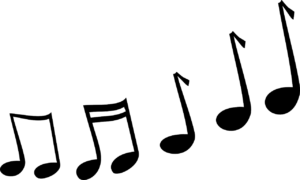by James Scott Bell
@jamesscottbell
 A question I’m asked from time to time is about whether or not an author can quote a song lyric in a novel.
A question I’m asked from time to time is about whether or not an author can quote a song lyric in a novel.
If you browse around the internet you’ll find almost universal agreement with this answer: No, you cannot quote a song without getting permission and paying a fee. Hard stop.
Actually, soft stop. The correct legal answer is—as in your first love or first attempt at a tax return—complicated.
The issue is whether a song—which is of course copyrighted material—is subject to the “fair use doctrine” just like other works, such as books. Fair use allows for a small portion of a work to be used under certain circumstances.
So the first thing to note is that there is no statute or court decision that exempts song lyrics from fair use. Zip.
However….
…the rules for applying “fair use” are about as clear as Mrs. Murphy’s chowder after the overalls have been tossed in. (Astute readers will recognize that I have just paraphrased a line from a song made popular by Mr. Bing Crosby. On the practice of paraphrase, see below).
So let’s take it step by step, for as Lennon and McCartney once put it, we must travel a rather long road that is winding. (Paraphrase!)
Here I must add, disclaimeringly, that this does not constitute legal advice (yadda-yadda). Take it as opinion, because unlike Billy Joe and Bobbie Sue in the Steve Miller song, I’m not anxious to take your money and run.
Fair Use Doctrine
In short form, the Fair Use Doctrine allows for quoting copyrighted material, based upon four factors:
(1) the purpose and character of the use, including whether such use is of a commercial nature or is for nonprofit educational purposes;
(2) the nature of the copyrighted work;
(3) the amount and substantiality of the portion used in relation to the copyrighted work as a whole; and
(4) the effect of the use upon the potential market for or value of the copyrighted work.
Courts have held that all of these factors must be taken into consideration, with no single factor carrying greater weight than the others. It all depends on the specific facts of the case—and on who gets to decide. It’s not clear whether a jury or a judge should be the fact finder (if you’re interested in a scholarly analysis of this issue, you can read this).
So any way you look at this area of law, you’re going to see murk.
A Hypothetical Case
Joe Doakes writes a novel about a rock band whose lead character likes to sing a line from a famous song every now and then. Joe is an indie author, and up goes the book.
Six months later he gets a cease-and-desist letter from a lawyer for the company that handles licensing the song. It states, in effect, Don’t you realize you have to pay for this? Withdraw the book now and pay us $1500 and we won’t take you to court.
Joe consults a lawyer friend, a rock drummer on the side, and true to his rebellious nature the lawyer says, “Let me write a letter for you, and I’ll handle this pro bono.”
The letter goes through each of the four fair use factors, and concludes: The most compelling factor is the effect of the use upon the potential market for or value of the song. That’s because far from causing you damage, the use is to your financial benefit. It’s free advertising. The lyric is quoted in a favorable light. If anything, this will lead to a portion of readers wanting to purchase or stream the song. Further, as the lyrics of the entire song are widely accessible on the internet, there is no possible way the use of one line in this book will affect the market or value in any way whatsoever. Respectfully yours, Joseph Doakes.
Now the company will have to decide if they want to pile up in-house lawyer fees to tangle with this guy Doakes. Doakes is taking a risk, of course, but he’s willing to do it. He’s a rocker, after all, and one of the things he likes to rock is boats.
It would indeed be interesting to finally get a court decision on this. The argument for fair use is strong, in my humble opinion. But litigation is fraught with uncertainties. Isn’t there another way? I’m glad you asked.
The Paraphrase Workaround
Joe Doakes can avoid the grinder of the courts by way of what I call “the paraphrase workaround.” Examples:
As I drove toward the police station, a song came up on the oldies station. Stevie Wonder was singing about the sunshine of his life and the apple of his eye. I loved that song! But all I could think of was the darkness in my own life and the dead body in my trunk.
Or:
As I drove toward the police station, a song came up on the oldies station. The Beatles were singing about going down to fields of strawberries, where nothing was real. Ha! I wished I could go those fields right now, because there was a very real dead body in my trunk.
No muss, no fuss. And, most important, no lawsuit.
Okay, so what if you really, really, really want to use the exact lyric? You can seek permission to quote, for a fee. How hefty that will be is also uncertain, because a company can charge whatever it wants to. I once got permission to quote an entire song, for a reasonable price. The conditions were that the use not be derogatory and that the front matter include their standard permissions language. Done and done.
But I’ve also seen outrageous fees for a single line. Should that happen to you, you can always try to negotiate. Or get Joe Doakes’s lawyer to do it for you.
(A helpful article on how to find who grants licenses for particular songs can be found here.)
Public Domain
One last note. Any song written before 1927 is now in the public domain. More come in each year. So how about this?
As I drove toward the police station, a song came up on the oldies station. Elvis!
Are you lonesome tonight? Do you miss me tonight? Are you sorry we drifted apart?
Yeah, I was lonely all right. But was I sorry we drifted apart? Was I sorry he was dead and in the trunk of my car? Um, no.
Wait, what? Elvis sang this in 1960. Yeah, but the song was published in 1926. You can now use it any way you please. (You can search for songs in the public domain here.)
This is a lot to digest, I know. But when you’re dealing with copyright law, contra Paul Simon’s advice, you really can’t think too much.

